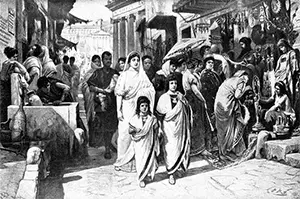Patricians and Plebeians in Ancient Rome
The people of Ancient Rome existed in three classes: patrician, plebeian, and slave.  Slavery was a large part of Roman society. Rome had public slaves and private slaves and used them for all kinds of purposes: Roman slaves were clerks, secretaries, even tax agents. They dug graves and mined gold and silver. They ran households and massive Roman gardens. Gladiators were slaves, too.
Slavery was a large part of Roman society. Rome had public slaves and private slaves and used them for all kinds of purposes: Roman slaves were clerks, secretaries, even tax agents. They dug graves and mined gold and silver. They ran households and massive Roman gardens. Gladiators were slaves, too.
Roman sources say that Romulus, the founder of Rome, chose 100 men to be the first members of the Senate and that he called these men patres, or fathers. This was the beginning of the patrician class, which ruled Rome for centuries. People in Roman society who were not patricians or slaves were plebeians. 
Patricians enjoyed several prime benefits of being the ruling class. They could hold political and religious office, meaning that they could make laws and set religious policy. Plebeians could do neither of those things. As well, when the head of the Roman government was a series of kings, every non-slave living in Rome (both the future patricians and the future plebeians) had access to public land; when the patricians took over, they kept that land for themselves and got rich from it. Rome was beset by invasions from time to time, and invaders sometimes damaged farms and homesteads. Plebeians who had little extra money struggled to pay for reconstruction of their assets and, in desperation, borrowed money. Patricians set the rules here, too, and didn't allow land to be used as collateral on a loan; instead, a plebeian, in order to get a loan, had to offer in return some kind of personal service. A farmer who defaulted on a loan faced two terrifying prospects: being sold into slavery or being killed. Not all who defaulted had to struggle with such punishments, but some did. At the same time, it wasn't always the case that patricians were rich and plebeians were poor. Many plebeians had a lot of money, some more than patricians did. Since the patricians made up most of the ruling class and made the laws, they tended to make laws to protect their own interests. If the interests of the plebeians got in the way, then the laws came first–at least that's what the patricians thought. Plebeians far outnumbered patricians in terms of sheer numbers; in raw power, however, patricians were superior. The plebeians had other ideas. They wanted certain basic rights, and they were willing to cause civil Other highlights of the Conflict of the Orders:
In 287 B.C., the Council of the Plebs got even more power through the Lex Hortensia, which stipulated that all laws passed by the Council of the Plebs applied to both patricians and plebeians. |
|
Social Studies for Kids
copyright 2002–2024
David White



 disturbances to get them. They even threatened to secede, in 494. In a great act of civil disobedience known as the Conflict of Orders, a number of plebeians gathered outside Rome and refused to move until the patricians gave them political representation. By this time, the sheer numbers of the plebeian class made the patricians sit up in their governing chairs and take notice. One immediate result was the Concilium Plebis, or Council of the Plebs; overseeing this were tribunes, elected by the council. Another result, 40 years later, was
disturbances to get them. They even threatened to secede, in 494. In a great act of civil disobedience known as the Conflict of Orders, a number of plebeians gathered outside Rome and refused to move until the patricians gave them political representation. By this time, the sheer numbers of the plebeian class made the patricians sit up in their governing chairs and take notice. One immediate result was the Concilium Plebis, or Council of the Plebs; overseeing this were tribunes, elected by the council. Another result, 40 years later, was 
